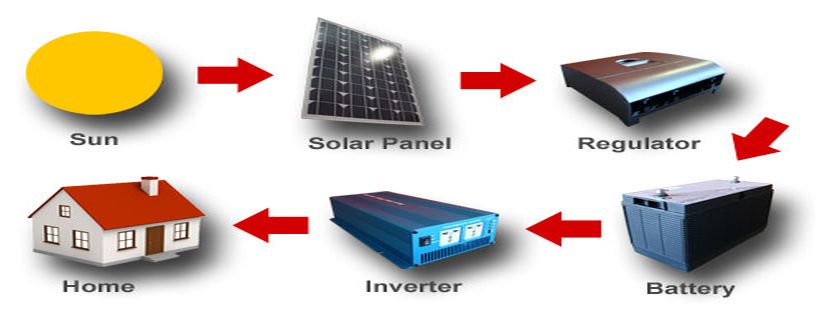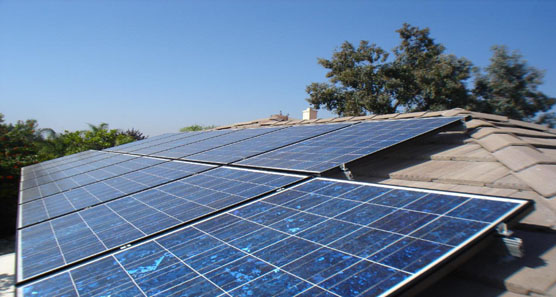

2015-11-04 12:00:00 AM | 6708 ![]() Print
Print ![]() PDF
PDF

PV cells are made from layers of semi-conducting material, usually silicon. When light shines on the cell it creates an electric field across the layers. The stronger the sunshine, the more electricity is produced. Groups of cells are mounted together in panels or modules that can be mounted on your roof. These cells do most of the work when it comes to solar panels converting the energy from the sun into electricity. Next up the electricity gets sent through a regulator, also known as a controller. This regulator ensures you send the right amount of solar energy to the batteries for storage. Without this process you could overcharge the batteries and ruin them quickly. Finally, the battery sends the electricity through an inverter which converts it from DC to AC and then it's ready to use for all your power needs. That in short, is how solar panels work.

Solar tiles are designed to be used in place of ordinary roof tiles. A system made up of solar tiles will typically cost around twice as much as an equivalent panel system, although you will save the money you would have spent on roof tiles or slates. Solar tile systems are not normally as cost-effective as panel systems, and are usually only considered where panels are not considered appropriate for aesthetic or planning reasons.
Costs (KVA = KW) The average domestic solar PV system is 3.5 to 4kVA and costs around £7,000 (including VAT at 5%), with the typical cost ranging from £5,500 to £9,500 at the time of writing. Costs have fallen significantly over the last year. They vary between installers and products, so we recommend getting quotes from at least the solar panels marketer that also include installation. Other factors that affect PV installation costs are: • The more electricity the system can generate, the more it costs but the more it could save. • Larger systems are usually more cost-effective than smaller systems (up to 4kVA). • PV panels are all around the same price per kVA, but PV tiles cost much more than a typical system made up of panels. • Panels built into a roof are more expensive than those that sit on top. Savings A 3.5kVA system can generate around 3,000 kilowatt hours of electricity a year – about three quarters of a typical household's electricity needs. It will save over a tonne of carbon dioxide every year. If you know your system size, you can get a tailored estimate for your system accessing our FREE QUOTE on our web site.
Solar PV needs little maintenance – you'll just need to keep the panels relatively clean and make sure trees don't begin to overshadow them. In the UK panels that are tilted at 15° or more have the additional benefit of being cleaned by rainfall to ensure optimal performance. Debris is more likely to accumulate if you have ground mounted panels. If dust, debris, snow or bird droppings are a problem they should be removed with warm water (and perhaps some washing-up liquid or something similar – your installer can advise) and a brush or a high pressure hose (or telescopic cleaning pole) if the panels are difficult to reach. Always be careful if you are working above the ground or near the top of a ladder. Alternatively, there are a number of specialist window cleaning companies who will clean solar PV panels for you at a cost (of around £30 based on our research in March 2012) depending on the size of your array and location. Many of these companies use a water fed pole system which does away with the need for a ladder. Once fitted, your installer should leave written details of any maintenance checks that you should carry out from time to time to ensure everything is working properly. This should include details of the main inverter fault signals and key trouble-shooting guidance. Ideally your installer should demonstrate this to you at the point of handover. Keeping a close eye on your system and the amount of electricity it’s generating (alongside the weather conditions) will familiarize you with what to expect and alert you to when something might be wrong. The solar panels should last 25 years or more, but the inverter is likely to need replacing some time during this period, at a current cost of around £1,000. Consult with your installer for exact maintenance requirements before you commit to installing a solar PV system.

Contained Energy Services Limited is a company dedicated at bring solar power and inverter to homes in Nigeria at affordable prices. We offer best warranty and after sales service that rivals others, you as a customer are a part of our big family. A fight against erratic power supply daunting your business efficiency and relaxation at home. Call 08099549798 or 08033319391 and lets see how we can be of assistance to you.